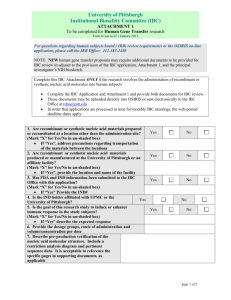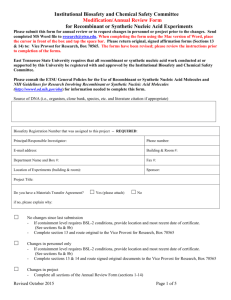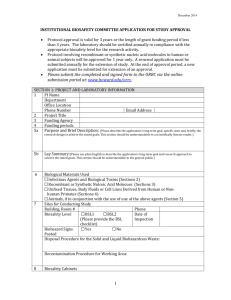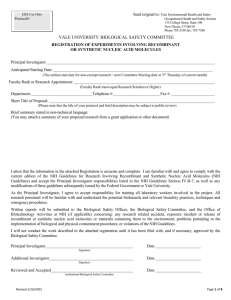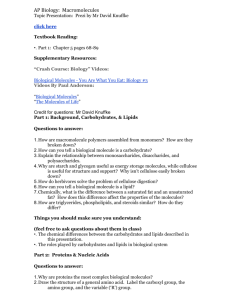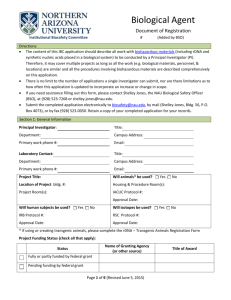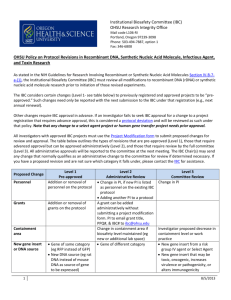April 2014 INSTITUTIONAL BIOSAFETY COMMITTEE
advertisement
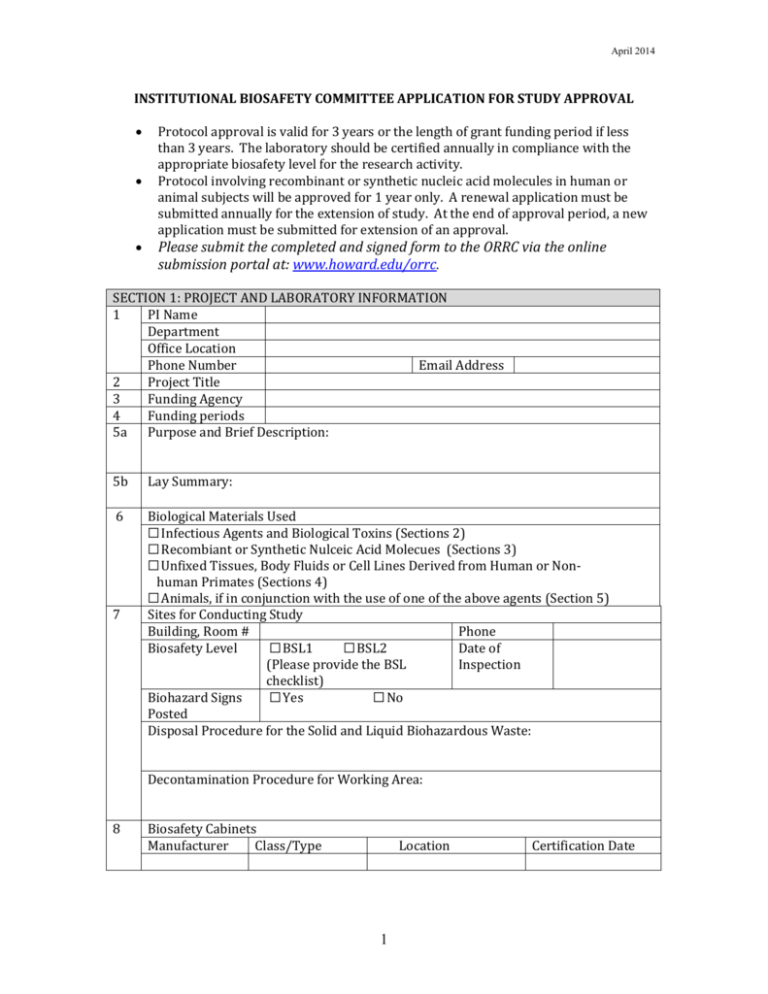
April 2014 INSTITUTIONAL BIOSAFETY COMMITTEE APPLICATION FOR STUDY APPROVAL Protocol approval is valid for 3 years or the length of grant funding period if less than 3 years. The laboratory should be certified annually in compliance with the appropriate biosafety level for the research activity. Protocol involving recombinant or synthetic nucleic acid molecules in human or animal subjects will be approved for 1 year only. A renewal application must be submitted annually for the extension of study. At the end of approval period, a new application must be submitted for extension of an approval. Please submit the completed and signed form to the ORRC via the online submission portal at: www.howard.edu/orrc. SECTION 1: PROJECT AND LABORATORY INFORMATION 1 PI Name Department Office Location Phone Number Email Address 2 Project Title 3 Funding Agency 4 Funding periods 5a Purpose and Brief Description: 5b Lay Summary: 6 Biological Materials Used ☐ Infectious Agents and Biological Toxins (Sections 2) ☐ Recombiant or Synthetic Nulceic Acid Molecues (Sections 3) ☐ Unfixed Tissues, Body Fluids or Cell Lines Derived from Human or Nonhuman Primates (Sections 4) ☐ Animals, if in conjunction with the use of one of the above agents (Section 5) Sites for Conducting Study Building, Room # Phone Biosafety Level ☐ BSL1 ☐ BSL2 Date of (Please provide the BSL Inspection checklist) Biohazard Signs ☐ Yes ☐ No Posted Disposal Procedure for the Solid and Liquid Biohazardous Waste: 7 Decontamination Procedure for Working Area: 8 Biosafety Cabinets Manufacturer Class/Type Location 1 Certification Date April 2014 Decontamination Procedure: 9 Personal Protective Equipment 10 Gloves Type Eye Protection Type Foot Protection Type Protective Clothing Type Respiratory Type Protection Others List Emergency Plan: (Please reference the IBC’s written Emergency Plan) (What are the courses of actions to manage the accident involving inadvertent skin contact, injection, ingestion, or inhalation of agents used, or the release of agents to the environment, such as the escape of genetically modified microorganisms, transgenic animals or plants?) Contact Person(s) 11 Name Non-Laboratory Phone Number Personnel (The table is expandable for additional space.) Name Role in Project Safety Training Certificate No. PI Certificate Expiration Date SECTION 2: USE OF INFECTIOUS AGENTS AND BIOLOGICAL TOXINS 12 Risk Group (RG) of Agent or Toxin Used ☐1 Agent that is not associated with human disease ☐2 Agent that is associated with human disease which is rarely serious and for which preventive or therapeutic interventions are often available ☐3 Agent that is associated with serious or lethal disease for which preventive or therapeutic interventions may be available ☐4 Agent that is associated with serious or lethal disease for which preventive or therapeutic interventions are not usually available 13 Use of the agent (The table is expandable for additional space.) Name of agent Source (If it is purchased or provided by other institute, please provide the name of provider, Safety Data Sheet, and Material Transfer Agreement in the attachment.) Will the agent be propagated or purified in the PI’s laboratory? Will the agent be introduced into animals or human? Please describe in detail how the agent will be used: 2 ☐ Yes ☐ Yes ☐ No ☐ No April 2014 14 Please list, if applicable, any diseases or pathologic effects associated with the agent in human or animals: 15 Please describe, if applicable, preventive and protective measures for the inadvertent injuries due to contact, injection, inhalation, or ingestion of agents or release of agents into environment, such as use of special personal protective equipment, immunization or serum surveillance program: SECTION 3: USE OF RECOMBINANT OR SYNTHETIC NUCLEIC ACID MOLECUES 16 Level of Approval (Refer to NIH Guidelines, Section III for details) Level Requirement (Check all that apply) III-A III-B III-C III-D ☐ Experiments involving the deliberate transfer of a drug resistance trait to microorganisms that are not known to acquire the trait naturally if such acquisition could compromise the ability to control disease agents in humans, veterinary medicine, or agriculture, ☐ Experiments involving the cloning of toxin molecules with LD50 <100 ng per kg body weight, ☐ Experiments involving the deliberate transfer of recombinant or synthetic nucleic acid molecules, or DNA or RNA derived from recombinant or synthetic nucleic acid molecules, into one or more human research participants, ☐ 1 Experiments using Risk Group 2, 3, 4, or restricted agents as host-vector systems, ☐ 2 Experiments in which DNA from Risk Group 2, 3, 4, or restricted agents is cloned into nonpathogenic prokaryotic or lower eukaryotic host-vector systems, ☐ 3 Experiments involving the use of infectious DNA or RNA viruses or defective DNA or RNA viruses in the presence of helper virus in tissue culture systems, ☐ 4 Experiments involving whole animals which have been genetically modified and experiments involving recombinant or synthetic nucleic acid -modified microorganisms tested on the whole animals, ☐ 5 Experiments to genetically engineer plants by recombinant or synthetic nucleic acid molecule methods, to use such plants for other experimental purposes, to propagate such plants, or to use plants together with microorganisms or insects containing recombinant or synthetic nucleic acid molecules, ☐ 6 Experiments involving more than 10 liters of cultured organism containing recombinant or synthetic nucleic acid molecules, ☐ 7 Experiments with influenza viruses generated by recombinant 3 Approval /Review NIH/Dir, RAC, IBC NIH/OBA, IBC RAC, IRB, IBC IBC April 2014 III-E III-F 17 or synthetic methods, ☐ 1 Experiments involving the formation of recombinant or synthetic nucleic acid molecules containing no more than 2/3 of the genome of any eukaryotic virus, ☐ 2 Experiments involving nucleic acid-modified whole plants, and/or experiments involving recombinant or synthetic nucleic acid -modified organisms associated with the whole plants, ☐ 3 Experiments involving the generation of rodents in which the animal's genome has been altered by stable introduction of recombinant or synthetic nucleic acid molecules, or nucleic acids derived therefrom, into the germ-line, Experiments involving synthetic nucleic acids that ☐ 1 (1) can neither replicate nor generate in any living cell, (2) are not designed to integrate into DNA, and (3) do not produce a toxin that is lethal for vertebrates at an LD50< 100 ng/kg body weight; ☐ 2 are not in organisms, cells, or viruses and that have not been modified or manipulated to render them capable of penetrating cellular membranes; ☐ 3 consist solely of the exact recombinant or synthetic nucleic acid sequence from a single source that exists contemporaneously in nature; ☐ 4 consist entirely of nucleic acids from a prokaryotic host when propagated only in that host or a closely related strain of the same species, or when transferred to another host by well-established physiological means. ☐ 5 consist entirely of nucleic acids from a eukaryotic host, excluding viruses, when propagated only in that host or a closely related strain of the same species; ☐ 6 consist entirely of DNA segments from different species that exchange DNA by known physiological processes, though one or more of the segments may be a synthetic equivalent; ☐ 7 are genomic DNA molecules that have acquired a transposable element, provided the transposable element does not contain any recombinant and/or synthetic DNA; ☐ 8 do not present a significant risk to health or the environment, as determined by NIH Director; ☐ recombinant or synthetic nucleic acid molecules in tissue culture, ☐ Escherichia coli K-12 host-vector systems, ☐ Saccharomyces host-vector systems, ☐ Kluyveromyces Host-Vector Systems, ☐ Bacillus subtilis or Bacillus licheniformis host-vector systems, ☐ extrachromosomal elements of Gram positive organisms, ☐ the purchase or transfer of transgenic rodents, ☐ generation of BL1 transgenic rodents via breeding. IBC IBC List all recombinant and synthetic nucleic acid molecules used in the project that will not be transferred into microorganism, tissue cultured cells, or animals and 4 April 2014 describe how these molecules will be used. 18 List all recombinant and synthetic nucleic acid molecules used in the project that will be transferred into microorganism, tissue cultured cells, or animals and describe the characteristics of these molecules (The table is expandable for additional space) Name of nucleic Source of the Source for the Presence of eukaryotic or acid molecule material1 origin of viral promoter replication2 1If it is purchased or provided by other institute please provide the name of provider, Safety Data Sheet, and Material Transfer Agreement. 2The source for the origin of replication could be bacterium, virus, yeast, fungus, human, or other eukaryotes. If it is a plasmid or viral vector, please provide its genetic map. Will it be propagated in PI’s laboratory? ☐ Yes. ☐ No. If it is a non-replicative viral vector, is helper virus ☐ Yes. Provide documented or cell line packed with replication required genes evidence for complete removal of used in the preparation of vector? the replication-required genes. ☐ No Does the insert, not including vector sequence, ☐ Yes. ☐ No. represent more than 2/3 of the viral genome? Please describe in detail how these nucleic acid molecules will be used. (Please include what cells or animals will be used as the hosts for each nucleic acid molecule, how the nucleic acid molecules will be transferred into these hosts, and what are the purposes of using the nucleic acid molecule in each host.) 19 Is this a deliberate attempt to express a foreign gene in the host? ☐ Yes ☐ No Will this expressed gene product be purified? ☐ Yes ☐ No What are the potential harms to humans for inadvertent exposure (contact, injection, inhalation, or ingestion) to the used nucleic acid molecule, expressed gene product, or host harboring this genetic construct? What will be the impact if the hosts of named nucleic acid molecules are inadvertently released into to the environment? How will the laboratory personnel be protected from such exposures or release? SECTION 4: USE OF UNFIXED TISSUES, BODY FLUIDS OR CELL LINES DERIVED FROM HUMAN OR NON-HUMAN PRIMATES 20 Type of BioSource (Please provide Material Transfer Agreement and Safety Data Sheet, if it is purchased or provided by other institute.) specimen 21 Does the bio-specimen carry the nucleotide sequence of cancer-causing gene or infectious agent? 5 ☐ No ☐ Yes, specify_____ April 2014 22 23 24 Will this bio-specimen be tested for the possible contamination of blood borne pathogens? ☐ Yes ☐ HBV ☐ HCV ☐ HIV ☐ HPV ☐ Others, specify__________ (Please provide a safety assessment from the Employee Health Department) ☐ No Please describe in detail how the bio-specimen will be used and processed. How will the laboratory personnel be protected from the exposures of infectious agents that may be present in the bio-specimen? SECTION 5: USE OF LIVE ANIMALS 25 Animal Species______________ Gender____________ Information Quantity_____________ 26 Location of Housing 27 Biosafety Level 28 Detail description of the procedures that will be conducted on the animals in the Animal Housing Facility. 29 What are the health risks to the animal caretaker? 30 What are preventive measures for such risks? 31 Will animals be removed from the housing area for study? How animals will be transported? 32 ☐ Yes ☐ No 33 Detail description of the procedures that will be conducted on the animals outside the animal housing facility. 34 How will the laboratory personnel be protected from the health risks that may incur? 35 Method of Decontamination of Equipment Used for the Animal Studies (The table is expandable for additional space.) Equipment Method of Decontamination 6 April 2014 ASSURANCE OF PI By attaching my name, I agree to the following 1) I have read and agree to comply with the requirement specified by the NIH Guidelines involving recombinant or synthetic nucleic acid molecules. 2) I have read and am familiar with the standard and special microbiological practices, containment equipment, personal protective equipment, and laboratory facilities recommended for the Biosafety level indicated by CDC/NIH applicable to this project. 3) I accept the responsibility for training and safety of all laboratory workers involved in the project. All research personnel are familiar with and understand the relevant biosafety practice, protective equipment and techniques, potential biohazards, and emergency procedures. 4) I verify that all items described above are accurate. PI Division Chair Printed name Signature Date Printed name Signature Date 7 April 2014 IBC Approval Application Checklist ☐ Completed IBC Application Form. ☐ Date of the most recent Laboratory Inspection ____________________________ ☐ Laboratory Biosafety Level checklist ☐ Biosafety Cabinet Inspection ☐ Copies of Certificate for the Completion of online safety training for all laboratory personnel ☐ Safety Data Sheet for purchased recombinant or synthetic nucleic acid molecules, infectious microorganisms, biological toxin, or human cell lines, if applicable ☐ Evidence for complete removal of the replication required genes in nonreplicative viral vector, if applicable ☐ Material Transfer Agreement if one of the following agents is provided by other institutions: recombinant or synthetic nucleic acid molecules; infectious microorganisms; biological toxins; and primary tissues, body fluids, and cell lines that are derived from human or non-human primates ☐ Grant proposal, if applicable ☐ Safety Assessment, if applicable 8


